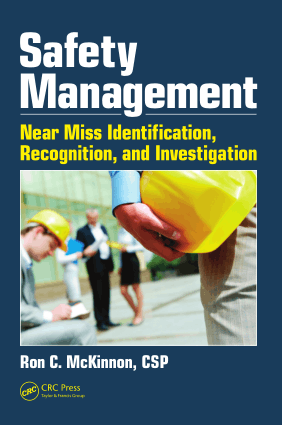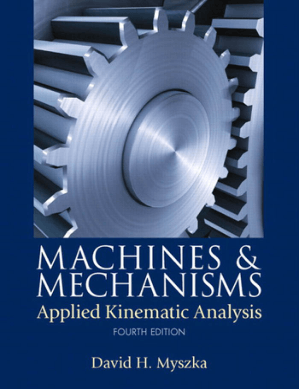Preface Refrigeration is an amazing area where science and engineering meet for solving the humankind’s cooling and refrigeration needs in an extensive range of applications, ranging from the cooling of electronic devices to food cooling, and has a multidisciplinary character, involving a combination of several disciplines, including mechanical engineering, chemical engineering, chemistry, food engineering, civil engineering and many more. The refrigeration industry has drastically expanded during the past two decades to play a significant role in societies and their economies. Therefore, the economic impact of refrigeration technology throughout the world…
Category: Mechanical Engineering
Safety Management near Miss Identification, Recognition, and Investigation By Ron C. McKinnon, CSP
Contents Preface……………………………………………………………………………………………………….xv Acknowledgments……………………………………………………………………………………….xix About the Author………………………………………………………………………………………..xxi Chapter 1 Introduction……………………………………………………………………………….1 Clearing the Confusion……………………………………………………………….1 Minor Injury Is Not a Near Miss Incident……………………………………..1 Near Miss Incidents…………………………………………………………………….2 Defining a Near Miss Incident…………………………………………………2 Defining an Accident………………………………………………………………2 Conflicting Definitions……………………………………………………………4 Accidents versus Near Miss Incidents…………………………………………..4 Accidents, Near Miss Incidents, and Injuries…………………………………4 Defining an Injury………………………………………………………………….5 General Agencies……………………………………………………………….5 Occupational Hygiene Agencies…………………………………………..5 Definitions: Injuries and Diseases…………………………………………………5 Work Injury…………………………………………………………………………..5 Occupational Disease…………………………………………………………6 Injury Compared to Accident………………………………………………6 Facts Concerning Undesired Events and Near Miss Incidents and Accidents………………………………………………………………………..6 Accident Sequence……………………………………………………………………..7 Failure to Assess the Risk……………………………………………………….7 Lack of Control………………………………………………………………………7 Basic Causes or Root Causes……………………………………………………8 Immediate…
Facility Piping Systems Handbook for Industrial, Commercial and Healthcare Facilities Third Edition By Michael Frankel, Cpd
CONTENTS Chapter 1.Codes and Standards Chapter 2.Piping Chapter 3.Solid-Liquid Separation and Interceptors Chapter 4.Water Treatment and Purification Chapter 5.Heat Transfer, Insulation, and Freeze Protection Chapter 6.Site Utility Systems Chapter 7.Turf Irrigation Systems Chapter 8.Cryogenic Storage Systems Chapter 9.Plumbing Systems Chapter 10.Special Waste Drainage Systems Chapter 11.Swimming Pools, Spas, and Water Attractions Chapter 12.Liquid Fuel Storage and Dispensing Systems Chapter 13.Fuel Gas Systems Chapter 14.Compressed Gas Systems Chapter 15.Vacuum Air Systems Chapter 16.Animal Facility Piping Systems Chapter 17.Life Safety Systems Chapter 18.Water Display Fountains and Pools Chapter 19.Nonpotable Water Systems Chapter…
Rolling Bearings
Principles of bearing selection and application A Bearing basics B Selecting bearing size C Friction D Speeds E Bearing specifics F Design considerations G Lubrication H Mounting, dismounting and bearing care Product data 1- Deep groove ball bearings 2- Y-bearings (insert bearings) 3- Angular contact ball bearings 4- Self-aligning ball bearings 5- Cylindrical roller bearings 6- Needle roller bearings 7- Tapered roller bearings 8- Spherical roller bearings 9- CARB toroidal roller bearings 10- Thrust ball bearings 11- Cylindrical roller thrust bearings 12- Needle roller thrust bearings 13- Spherical roller thrust bearings 14- Track runner bearings 15- Engineered products…
Manual of Engineering Drawing Second edition By Colin H Simmons and Dennis E Maguire
Contents Drawing office management and organization Product development and computer-aided design CAD organization and applications Principles of first and third angle orthographic projection Linework and lettering Three-dimensional illustrations using isometric and oblique projection Drawing layouts and simplified methods Sections and the sectional view Geometrical constructions and tangency Loci applications True lengths and auxiliary views Conic sections and interpenetration of solids Development of patterns from sheet materials Dimensioning principles 100 Screw threads and conventional representations Nuts, bolts, screws, and washers Keys and keyways Worked examples in machine drawing Limits and fits…
Machines and Mechanisms Applied Kinematic Analysis Fourth Edition By David H. Myszka
PREFACE The objective of this book is to provide the techniques necessary to study the motion of machines. A focus is placed on the application of kinematic theories to real-world machinery. It is intended to bridge the gap between a theoretical study of kinematics and the application to practical mechanisms. Students completing a course of study using this book should be able to determine the motion characteristics of a machine. The topics presented in this book are critical in machine design process as such analyses should be performed on design…
Heat Transfer in Process Engineering By Eduardo Cao
CONTENTS Chapter 1. Introduction Chapter 2. Heat Transfer Fundamentals Chapter 3. Heat Conduction in Solids Chapter 4. Convection Chapter 5. Fundamentals of Heat Transfer Between Fluids Chapter 6. Shell-and-Tube Heat Exchangers Chapter 7. Thermal Design of Shell-and-Tube Heat Exchangers Chapter 8. Finned Tubes Chapter 9. Plate Heat Exchangers Chapter 10. Condensation of Vapors Chapter 11. Boiling Chapter 12. Thermal Radiation Chapter 13. Process Fired Heaters INTRODUCTION This book has been written with the double purpose of being used as a textbook for university courses in unit operations and as a…
Industrial Refrigeration Handbook Stoecker By Wilbert F. Stoecker
Introduction Both air conditioning and industrial refrigeration have a common objective, cooling some substance. Both types of systems are constructed of common hardware compressors, heat exchangers, fans, pumps, pipe, duct, and controls. The predominant working fluids are air, water, and refrigerants. A refrigeration system is an integral part of both systems. While much is shared by both fields, there are enough differences in the systems, components, design practices, and business methods to justify the separate treatment of industrial refrigeration. By almost every standard, the size of the comfort air conditioning…







